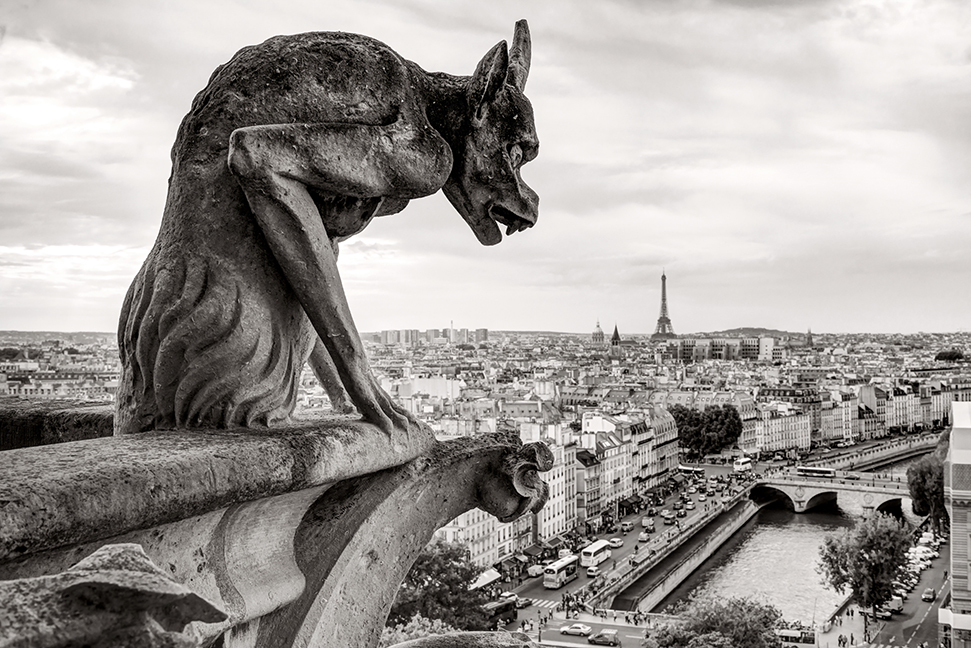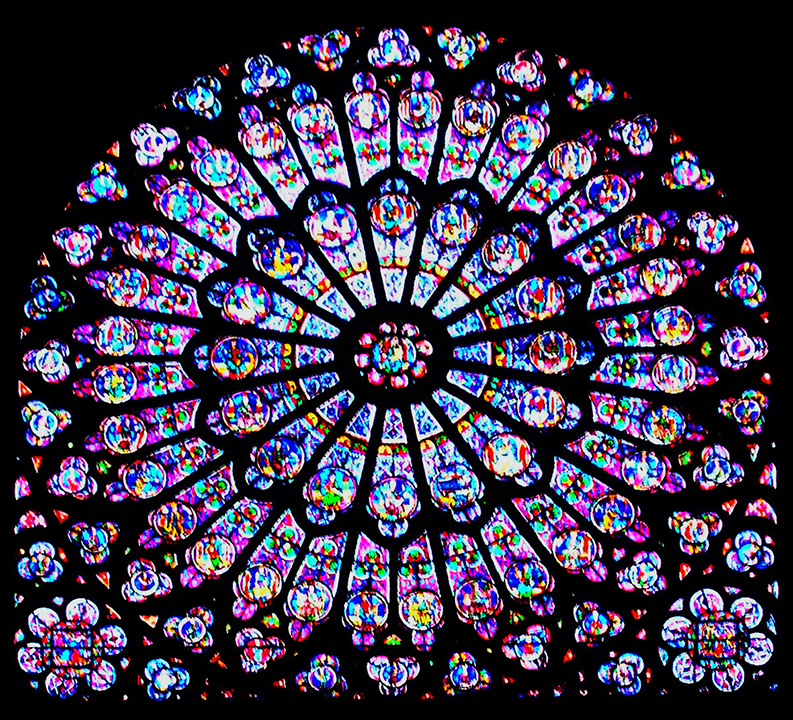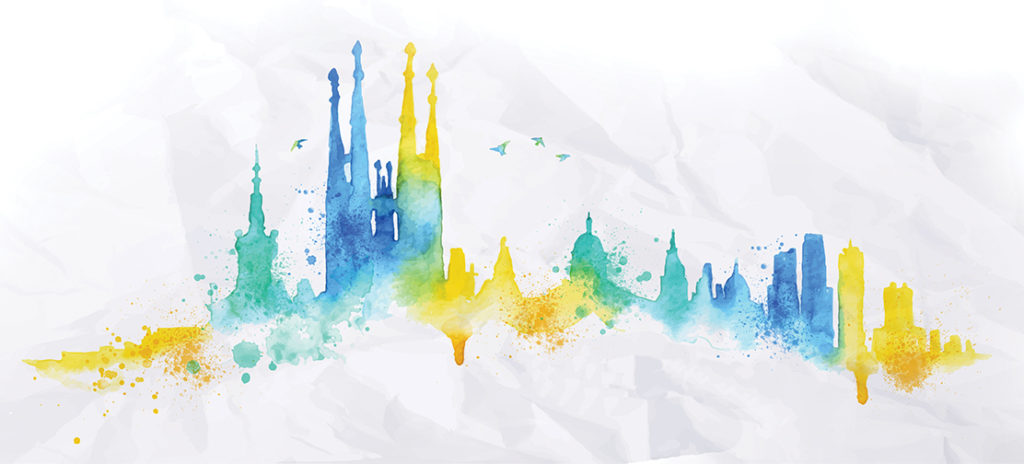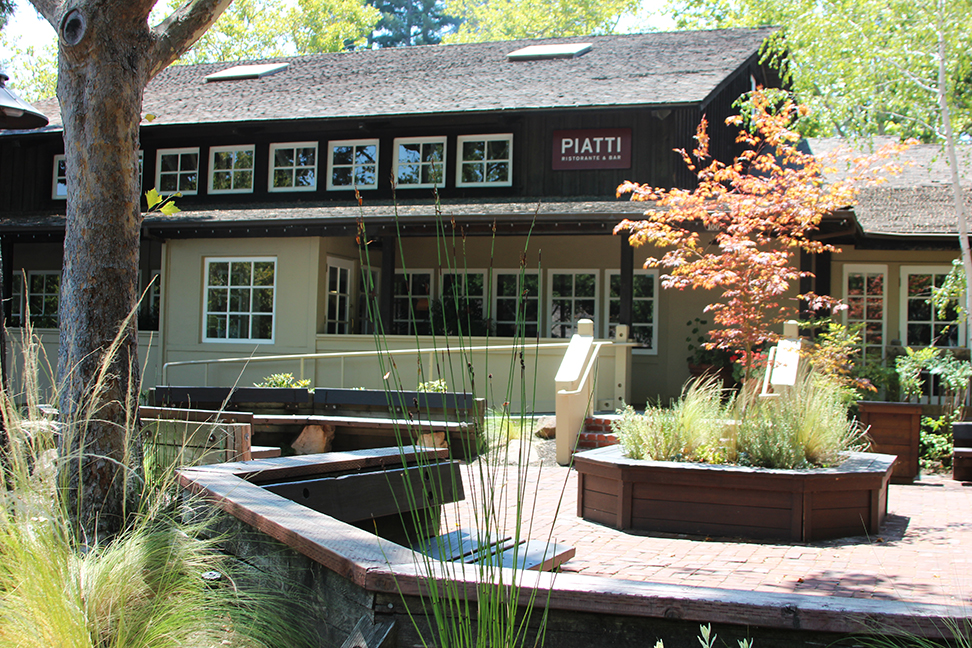I was able to visit the Notre Dame de Paris Cathedral twice in my life. The first time was in 1954, when our family had been required to travel to the United States Embassy in Paris to apply for entry into the United States, in person, as emigrants. My second visit took place fifty four years later, in 2008, when my wife Bonnie and I travelled to Europe to attend my daughter Christina’s nuptials to her new husband Doug, in Praiano, Italy. Bonnie wanted to see Paris as she had never been there before. This second trip was a fun adventure, whereas the 1954 trip had to be undertaken out of necessity.

Although my 1954 visit to Paris had been my first, I and all the other little kids going to school in Algrange (Moselle district of north-eastern France) had seen plenty of photographs and artwork featuring Notre Dame. We had also been required to read the novel by Victor Hugo entitled The Hunchback of Notre Dame which, by the way, in French was simply, Notre Dame de Paris or Our Lady of Paris.
We all knew about the Notre Dame Cathedral in Paris, because by 1954, we had been treated to the movie The Hunchback of Notre Dame, the American version starring Charles Laughton and Maureen O’Hara, produced in 1939. The film was of course based on the aforementioned Victor Hugo’s 1831 novel. Of course, in Algrange, when we went to see the movie at the Odeon Theater, the title on the marquee was Le Bossu de Notre Dame, which had been a translation of the American title, referencing the Hunchback.

Now unfortunately, in Algrange, in the 1950s, you couldn’t buy popcorn in movie theaters. The French people would tell us “zee corn is for zee peegs!” We could buy cacahouettes (peanuts) and marron rôties (roasted chestnuts) at the theater, along with assorted candies and ice cream; but NO popcorn! Can you imagine that? I know, this was somewhat of a detour, but the whole popcorn issue really bugged me…
The first time that I visited the Notre Dame I was 12. My father had told me that I should be amazed by the grandeur of the massive 750 year-old structure. At 12, I must admit that it looked like a gigantic church, twice or three times bigger than the one I had to attend every Sunday. It was dark and smoky inside, and I couldn’t even see the enormous arches making up the ceiling. The smell of incense was overwhelming and a priest was singing the mass; the same mass I heard every Sunday, unless we attended the Protestant church, where they didn’t sing the service. By 12, I knew practically the whole Catholic mass Dominus vo biscum – et cum spiritu tuo – Oremus. Translated: “The Lord be with you, and your spirit, let us pray.” By the time we sat down, I was totally in sync with the lyrics the priest was singing.

As we finished our prayer, some balding monks in dark brown habits with hoods, straight out of the Middle ages, came by for donations, and back then, these monks didn’t take “NO” for an answer. When the basket at the end of a long pole, came by our way, right under my nose, my father put a pocketful of change into the basket. However, the stone-faced monk didn’t seem to think it was sufficient. So, he kept shaking the basket under my dad’s nose until he plunked in a one hundred Franc note (that was a lot, at the time). As the basket finally moved on to the next isle, my dad’s face was red. “This is outrageous,” he grumbled. “They now charge us for praying to God,” he went on rather loudly to my Mom. He then suddenly got up and told us we were leaving. He wouldn’t even let me finish singing the rest of the mass. I was somewhat disappointed, but he had me by the hand. That was literally the sum total of my visit to the Notre dame de Paris, in 1954, the very first time I saw her.
As a side note here, so you understand: while I was baptized Calvinist (Hungarian Protestant) we attended most Protestant services as well as Catholic masses, as my mother was Catholic. The agreement between Mom and Pop had been, if I was born a girl, I would be baptized Catholic. As a boy, I got baptized Protestant. While attending school in Algrange, all lower grades were public school and therefore Catholic. We only found out later that there was a small mixed belief school, farther down the road.

Anyway, while I was in the third grade, our catechism teacher, Père François (Father Francis), decided that I should be an altar boy because he noticed how I enjoyed singing the mass along with the priest. Of course, I missed my chance when I got transferred to Ecole Mixte (Mixed School) and they discovered that I was really Protestant. After that, I didn’t see Père François very often. I think I would have made a great altar boy.
I did learn to appreciate the history, beauty, resilience, and significance of Our Lady of Paris, once I grew a little older and we moved away from France to the United States. Over the years, friends from France would occasionally send me postcards with Notre Dame on them. And I learned over the past few years about several attempts to destroy this symbol of Catholicism, well really, Christianity, as well as the pride of the French people. There have been as many as four or five attempts at blowing up Our Lady, by the so-called Islamic State or ISIS. Luckily, these attempts were stopped in their tracks before they could do any damage. But our Lady of Paris actually survived many other ordeals with minor or reparable damage, over the centuries.
Did you know that Nazi General Dietrich Von Choltitz, when appointed as military governor of Paris in 1944, refused to destroy the city and reduce it to ashes, when so ordered by Hitler himself, because the general loved the beauty and architecture of Paris? This of course also saved Notre Dame from destruction. When Choltitz died in 1966, French generals attended his funeral in Baden because they deeply respected the bravery of the man who had defied the Führer, and had saved Paris and Notre Dame from destruction.
There had been several other attempts at destroying France’s religious and architectural symbol, some even by her own people. Around 1793, during the French Revolution, angry, anticatholic mobs and revolutionaries looted the medieval Gothic masterpiece during their bloody attempt to force France to sever ties to the Roman Catholic Church, and more specifically, the influence of Rome. A number of the statues, representing twenty-eight generations of kings of Judah, affixed to the church façade, above the massive doors, were publicly decapitated by the revolutionaries, the same year as Marie Antoinette was marched to the guillotine. This was a very dark period in France’s history, when the working class, calling themselves the Sans-Culotte or “without-breeches,” took to the streets of Paris and tried to make things right; the wrong way.
The Notre Dame de Paris was built on the Île de la Cité (or Island of the city), a rather large island in the middle of the Seine river, which is now connected to the rest of Paris by ten bridges to both banks of the river and to the Île Saint-Louis (or Saint Louis Island). The oldest surviving bridge is the Pont Neuf (New Bridge), which traverses the western pointed tip of the island, connecting both banks. Back in the really old days, before the cathedral was built, the island served as a mostly inaccessible fortress, to fend off Romans, Vikings, Huns and other assorted bands of marauding barbarians.
So, why the history lesson, you may want to ask. I wanted to show you what I had learned over the years about Our Lady of Paris, that I not only didn’t know at age 12, but also didn’t understand nor appreciate: how those builders of yore, from over 750 to 800 years ago, not only envisioned this masterpiece of religious architecture but were then able to turn it into reality with the tools of the time and without electricity at their disposal. I also learned to admire the resilience of Our Lady of Paris, having gone throughall the turmoil and still be standing, even today, although severely injured.
Back in 2008, when my wife and I spent four days in Paris, at the beginning of our European journey, we visited Our Lady of Paris on a beautiful, sunny day. We walked from our charming little hotel in the Latin Quarter and crossed Petit Pont (little Bridge) over the Seine and followed ‘Promenade Maurice Carême’ to Rue D’Arcole and here we were facing the Notre Dame.This was a real treat for Bonnie as she had never been to Paris. What she didn’t realize was that it was also a real treat for me. The day was beautiful and bright as opposed to 1954, on my first visit, when it had been gray and overcast. It was mid-morning and there weren’t a lot of people yet as there would be later on.
When you enter through the massive door, you truly feel as though you are on a pilgrimage and that somehow God may listen to you within this cavernous interior. Bonnie and I slowly toured the interior of the cathedral and I tried to take as many photographs as possible. Unfortunately, no flash photography was allowed, so no matter how steady I was able to hold my little camera, I missed a few good ones. More and more people started pouring in as we kept exploring and several good shots I was trying to take, ended up with a big head right in the middle.
We lit a couple of candles in memory of those who’d gone before us and my memory rewound back to 1954, when we had exited the cathedral in such a hurry and it made me wonder what had happened to the old, bald monks who used pass the collection baskets under the worshippers’ noses. On this occasion, we didn’t see any. Apparently, although services were still held in the cathedral, the monks had either moved out or moved on. I almost missed them, because in retrospect, they had added a certain sense of austere discipline and devotion in maintaining the serenity of the place. Although, remembering my dad, serenity would have been the last thing I would have attributed to him. But that was way back then. Now, in the twenty first century, everyone seemed to be more at ease, as though visiting a museum and not necessarily being in the presence of divinity. In a sense, this was sad. Although filled with statues, frescoes and marvelous stained-glass windows, including the beautiful north side Rose window, I still felt somewhat reverent while observing and touching the walls and some of those ancient relics such as the crown of thorns said to have been worn by Jesus Christ.
As I mentioned earlier, there were a great number of statues, inside and out. There was one special one dedicated to ‘Sainte Jeanne D’Arc’ or Joan of Arc, who was beatified on April 18, 1909. I was very familiar with her tale, as I had to write a report on her in my fifth-grade class at the Algrange ‘Ecole Mixte’. She was born in 1413. She led the armies of Charles VII to several victories gaining the crown of France for him. Unfortunately, she was captured at Compiègne by rebellious French allies of the British, put on trial and sentenced to death by pro-British French cardinal, Pierre Gauchon. When we had read that Gauchon sentenced Joan of Arc to death, the whole class renamed him Gauchon le cochon (the pig), we were so upset. What do you expect from little kids anyway? The brave young warrior was burned at the stake on May 30, 1431.
In addition to Joan of Arc, there are statues of kings and saints and whole gangs of gargoyles, all around the perimeter of the towers and the spire. Originally installed to keep rain water from damaging the structure of the cathedral, gargoyles are now just decorations and protrusions for the birds to perch on. Some look like scary, deranged creatures from Hades, some are long-beaked birds, and some are a cross between a human and the devil. Now, whose idea it was to decorate the top of the towers with these creatures, is beyond me. The way I understood, they weren’t part of the original plan and were actually installed a couple centuries later. Either way, they are fascinating and fun to photograph and draw.
The other day, when I heard on the radio that Notre Dame was burning, I couldn’t believe it. Who would do such a thing, I thought to myself? I was certain that it had to be terrorists. I had been wrong. When I finally got home to my TV, I was shocked to see the images of the clouds of smoke rising from the great cathedral, and to find out that it had been a bad accident, more than likely caused by the workers doing the renovation.
Notre Dame was built over a period of some 200 years. The project was started in 1163, during the reign of King Louis VII of France, and in the presence of Pope Alexander III, the first stone was laid. King Philip VI was the ruler of France when the project was finally finished in 1345. So, 856 years from the beginning of its construction and 674 years from the completion, a nasty fire almost destroyed Our Lady of Paris. Fortunately, enough of the structure is left that Président de la République Emmanuel Macron has vowed to have the cathedral rebuilt. As of the writing of this article, it has been announced in the media that several million Euros have already been raised for the reconstruction.
If I have a chance to visit Paris just one more time, I will want to see a resurrected Notre Dame, with all the art and artifacts returned inside, just the way I remember seeing it was back in 1954 and again in 2008. I believe, it will take a great deal of money, much of which has fortunately already been raised, to accomplish the task of restauration, but I’m willing to bet that the money will keep flowing in from all over the globe, from all the visitors who had seen the beauty of Our lady of Paris. I’ll also be sure to chip in all I can, for all the great memories of my visits there.

